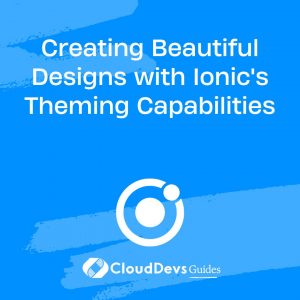Creating Beautiful Designs with Ionic’s Theming Capabilities
In the world of mobile app development, a visually appealing design can make all the difference. It can captivate users, enhance user experience, and establish a strong brand identity. Ionic, a popular open-source framework for building cross-platform mobile applications, offers a powerful theming system that empowers developers to create beautiful designs with ease. In this blog, we will dive deep into Ionic’s theming capabilities and explore various techniques, code samples, and best practices to unleash your creativity and create stunning designs for your Ionic apps.
Understanding Ionic’s Theming System:
Ionic’s theming system is based on CSS variables, which allow you to define and apply styles to various components and elements in your app. The system provides a set of predefined CSS variables that control the look and feel of the entire application, making it easy to customize the app’s visual appearance. These variables can be overridden or extended to match your specific design requirements.
Leveraging CSS Variables for Dynamic Theming:
One of the key advantages of Ionic’s theming system is the ability to dynamically change the app’s theme at runtime. By utilizing CSS variables, you can create multiple themes and switch between them based on user preferences or application settings. For example, you can define light and dark themes and toggle between them with a simple function call. This flexibility allows you to provide a personalized user experience and adapt to different environments seamlessly.
Here’s an example of how you can define and switch between different themes using Ionic’s theming system:
scss
// Define light theme
:root {
--ion-color-primary: #3880ff;
--ion-color-secondary: #0cd1e8;
--ion-color-tertiary: #7044ff;
}
// Define dark theme
:root.dark-theme {
--ion-color-primary: #121212;
--ion-color-secondary: #222222;
--ion-color-tertiary: #333333;
}
// Function to toggle between themes
function toggleTheme(darkMode) {
document.body.classList.toggle('dark-theme', darkMode);
}
Customizing Ionic Components with SCSS:
Ionic provides a wide range of pre-built UI components that can be easily customized to match your design vision. The flexibility of Ionic’s theming system extends to individual components, allowing you to override default styles and define custom styles using SCSS (Sass) variables.
To customize a specific component, you can create a new SCSS file and import it into your project. Within the SCSS file, you can override component-specific variables to achieve the desired look and feel. For example, if you want to customize the button component, you can create a file called _button.scss and define your custom styles:
scss
// _button.scss
ion-button {
--background: #ff4081;
--color: #ffffff;
--border-radius: 10px;
}
Import the custom SCSS file into your project’s main SCSS file:
scss // styles.scss @import 'button';
Creating Beautiful App Layouts:
Ionic’s theming system is not limited to individual components; it can also be used to create visually stunning app layouts. By leveraging Ionic’s grid system and CSS variables, you can achieve responsive designs that adapt to different screen sizes and orientations.
To create a beautiful app layout, you can define custom CSS variables for spacing, font sizes, and colors, and apply them throughout your app. This ensures consistency and coherence across different screens and enhances the overall user experience.
Designing Custom UI Elements:
While Ionic provides a rich set of UI components, there might be instances where you need to create custom UI elements to match your unique design requirements. Ionic’s theming system allows you to create and style custom components easily.
You can use Ionic’s component styling API, such as ion-button or ion-card, to create new components and define their styles. By leveraging the power of CSS variables and SCSS, you can achieve a cohesive design language that seamlessly integrates with the rest of your app.
Theming with CSS Utility Classes:
Ionic also offers a set of CSS utility classes that can be applied directly to HTML elements to quickly achieve specific styling effects. These utility classes provide a convenient way to apply common styles without writing custom CSS.
For example, you can use utility classes like ion-text-center to center-align text, ion-padding to add consistent padding, or ion-margin to control element spacing. By combining utility classes with CSS variables, you can create beautiful designs efficiently.
Best Practices for Designing with Ionic’s Theming Capabilities:
To make the most of Ionic’s theming capabilities, consider the following best practices:
- Define a consistent color palette: Create a color palette that reflects your app’s branding and use it consistently throughout your app.
- Plan for light and dark themes: Design your app to support both light and dark themes to accommodate user preferences.
- Test on different devices and screen sizes: Ensure your design looks great on various devices and screen orientations by testing across different form factors.
- Optimize performance: Keep your theming code modular and lightweight to ensure optimal app performance.
Conclusion:
Ionic’s theming capabilities provide developers with a powerful toolset to create visually stunning designs for their mobile applications. By leveraging CSS variables, SCSS, and CSS utility classes, you can customize and style your app’s components, layouts, and even create custom UI elements. By following best practices and considering user preferences, you can create beautiful and engaging designs that enhance the user experience and establish a strong brand identity. So, unleash your creativity and dive into the world of Ionic’s theming system to create stunning designs for your next app project.
Table of Contents








